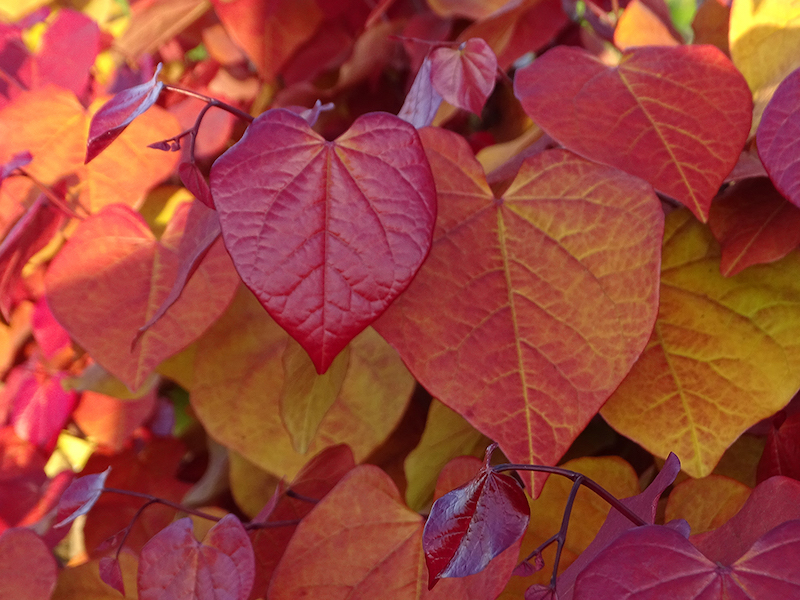Cercis canadensis ‘Eternal Flame’® won ‘Plant of the Year’ 2021 at RHS Chelsea on 20th September, but what makes a winning plant?
‘Eternal Flame’® was introduced to the market by Suttons through an exciting collaboration with Hillier and through partner exhibitor Stonebarn Landscapes.

Suttons’ Horticultural Team explain why they love this special new shrub…
Why does Suttons love Cercis canadensis ‘Eternal Flame’®?
It’s a winner for autumn lovers! This breading breakthrough offers what looks like autumn colour but for seven months of the growing season.
From May to November, you will have a stunning combination of newly emerging, vibrant red leaves which then turn orange and change again to golden yellow. It also boasts stunning, bright pink blooms on its bare stems before bursting into leaf in late April and early May.

How and why was ‘Eternal Flame’® developed?
It was developed in a 25-year breeding programme by Dr Dennis Werner of North Carolina State University. He crossed a golden leaved variety with a red-leaved variety and amazingly created this plant! The unique colour display is a consequence of the co-expression in the same leaf of the genes for both purple and gold leaf.
Dr Dennis Werner knew this variety would be a real winner from the very start; as the first seedling started to grow after the successful cross, he realised the leaves were unlike anything he’d seen before. The strong colours didn’t fade and the multi-coloured foliage didn’t revert back to green during the summer months as expected.
Why is it a worthy winner?
Simply put, it offers the innovation, appeal and impact that the judges were seeking. This sensational new shrub offers the gardener seven months of amazing, autumn-like colour. It’s a real breakthrough in breeding, with strong colour and an appealing form that not only wowed the judges – it will stand the test of time too.
Where should I plant ‘Eternal Flame’® in my garden?
This versatile new shrub is suitable for every size of garden – from a pot on the patio to large flower beds. It is easy to grow in virtually any soil (only avoid damp areas) and is fully hardy in UK conditions.
In the garden, and with light pruning after flowering, you can keep Cercis canadensis ‘Eternal Flame’® as a large shrub or leave it alone and it will become a small tree reaching 3m to 4m in height.
Afternoon and early evening sun shining through the red, orange and golden heart-shaped foliage is one of the wonders of the garden. Some leaves reflect the light whilst others appear translucent, the overall effect being a tapestry of different shades and glorious colour.
Wherever you choose to plant it, the fiery foliage is sure to delight you.
An Award-Winning Collaboration
Cercis canadensis ‘Eternal Flame’® has been introduced to the 2021 market through an exciting collaboration between Hillier and Suttons.

This joint venture will ensure that this wonderful new variety is made available to the widest range of gardeners via multiple sales channels.
How is the ‘Plant of the Year’ award judged?
The judging panel comprises of a group of experts with a wealth of knowledge and passion who come together, volunteering their time to make the incredibly tough decision on the winning plant. The judges will be looking for the winning criteria which will need to include all three of the following features:
Innovation – The plant must be genuinely new and offer significant benefits within those features. This will outweigh a new colour on an existing plant for example.
Appeal – Will the plant stand the test of time? It will need to sustain its popularity to secure a place with those of true significance.
Excellence & Impact – Both judges and gardeners will be looking for the “wow” factor.
Three Wins Since 2017!
This win marks the third in Suttons’ history at RHS Chelsea. Suttons was also delighted to introduce, through its partner exhibitors, the winning ‘Plant of the Year’ varieties in 2017 with the Dwarf Mulberry ‘Charlotte Russe’ and in 2019 with Sedum ‘Atlantis’.
Last Updated on March 14, 2023 by Suttons Horticultural Team





I’m at 1000 in the north. Is it tender?